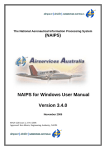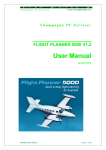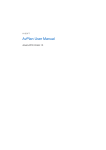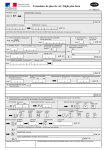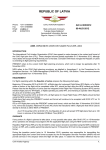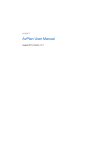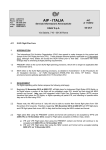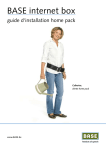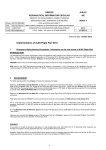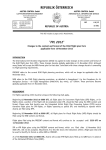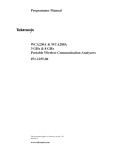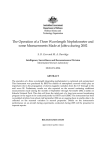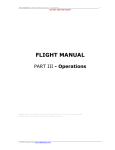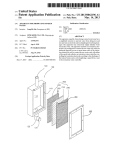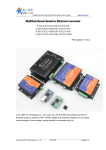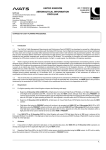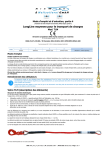Download Frequently Asked Questions
Transcript
NAIPS Internet Service Frequently Asked Questions Version 2.0 NAIPS Internet Service (NIS) FAQ Version 2.0 1. I am having problems logging in to the NIS. ................................................................ 4 2. I have a NAIPS account but I cannot access it and the forgotten password tool says “Unknown User”. WHY? ................................................................................. 4 3. I received an Avfax briefing yesterday but my NAIPS User Account is gone today. WHY? ..................................................................................................................... 4 4. I’m logged in, how do I change my password? ............................................................ 4 5. Why is there a need to supply and maintain a current email address? ................... 4 6. Why does NAIPS demand password changes? There is nothing secret in NAIPS right? ...................................................................................................................... 5 7. How do I recover a forgotten password if I do not have a registered email address, or my email address has changed? .............................................................. 5 8. What if my details change? ............................................................................................. 5 9. I access templates that were previously entered into NAIPS by the Briefing Office. How do I access these files?.............................................................................. 5 10. What is a NIS Group? ...................................................................................................... 6 11. What can a Personal User as opposed to a Group Manager or Group Member save and overwrite in the NIS?....................................................................... 6 12. Is there an option to save a location briefing to a template that can be used again? ................................................................................................................................. 6 13. How do I specify different Wake Turbulence categories in creating a Specific Pre Flight Information Bulletin (SPFIB) for multiple stages? ..................................... 7 14. When I open a NfW file in the SPFIB form, the Weight Category stays of LLight despite my file having a M-Medium category. Why? ........................................ 7 15. The Wind / Temperature profile is not showing International routes........................ 7 16. In a restricted area briefing it mentions airspace groups, what are these?............. 7 17. Why do I have to do everything in code? Can’t I use place names? ....................... 8 18. Why don’t you present MET information in English and not computer speak? ...... 8 19. My FIR NOTAM briefing is too long and contains NOTAMs too far away from where I will fly, how do I narrow it to just the ones relevant to my flight? ................ 8 NAIPS Internet Service FAQ 2.0 Page 2 of 15 20. What is an SPFIB and how to I use it?.......................................................................... 8 21. What does the 9xxx code mean in an Area Briefing?................................................. 9 22. Why can’t I generate an Avfax Custom Code briefing from the Avfax - Custom Code menu? ...................................................................................................................... 9 23. Where do I find Avfax product codes? .......................................................................... 9 24. How can I change an Avfax Custom Code? ................................................................ 9 25. Can I use a group custom code when using the Avfax dial up service? ................. 9 26. Can I create Avfax Custom Codes with letters? ........................................................ 10 27. Can an Avfax Group custom code and a Personal custom code be retrieved from a single Avfax briefing? ........................................................................................ 10 28. Will I receive an email on amending or cancelling a flight notification? ................. 10 29. I need help in filling in a flight notification form. ......................................................... 10 30. I get the error message “A Flight Notification for [XXXXXXX] is a duplicate of one submitted by another user”.................................................................................... 11 31. ICAO FPL 2012 introduces some new fields in Item 18 and ORGN/ is one of those items. What information should be recorded here? ....................................... 11 32. How do I put a delay for AWK or approaches into my FN? ..................................... 11 33. What if my departure or destination does not have a code? ................................... 12 34. My NAIPS for Windows SARTIME Flight notification template does not load into the NIS flight notification. ....................................................................................... 12 35. How do I save variable information into a NIS saved flight notification? ............... 12 36. How do I represent ADS-B in a flight plan? ................................................................ 12 37. Military: How should flights with NOCOM requirements input this information? .. 13 38. We have an in-house system to connect to NAIPS, so will that work with the NIS? .................................................................................................................................. 13 39. I want to write a software program to interface with NAIPS. Can I be provided with information that would let me exchange data with Airservices? ..................... 14 40. Is there a charge for using the NIS? ............................................................................ 14 41. I’m using Microsoft Internet Explorer as my web browser and experiencing lots of errors. What other browsers are recommended? .......................................... 14 42. NIS is taking a long time to respond to requests and submissions. Why? ........... 15 NAIPS Internet Service FAQ 2.0 Page 3 of 15 1. I am having problems logging in to the NIS. There could be a few issues preventing you from logging into the NIS. The error in RED will give a description of the issue. Invalid User Name or Password, please try again Check your User ID and retype your password and try again. NOTE: Passwords are CASE SENSITIVE. If you are still having issues, use the Forgotten Password tool. NIS requires a minimum seven (7) character password with a mix of Alphabetic and Numeric characters. 2. I have a NAIPS account but I cannot access it and the forgotten password tool says “Unknown User”. WHY? As part of security measures, User Accounts that are not accessed for approximately 12 months are purged by NAIPS. You will need to complete an application for a new NIS User Account. This will only take 2-3 minutes and you will receive an instant notification that it is active. 3. I received an Avfax briefing yesterday but my NAIPS User Account is gone today. WHY? Accessing Avfax does not reset the NAIPS access clock and NAIPS will purge unused accounts after approximately 12 months of non-use. 4. I’m logged in, how do I change my password? To change your password, scroll down the left hand side of the page, click on Account Management Change Password. 5. Why is there a need to supply and maintain a current email address? More and more, email is the preferred method of many people to receive information and NAIPS is being changed to cater for this need. Initially, email will be used by NAIPS to automatically send flight plan confirmation messages to users and it will also be used for confirmation and recovery of user accounts and forgotten passwords. NAIPS Internet Service FAQ 2.0 Page 4 of 15 In the future, changes to flight plans and automated delivery of briefing products will be enabled. 6. Why does NAIPS demand password changes? There is nothing secret in NAIPS right? NAIPS Password Security - A password reset is required every 180 days for NAIPS access and accounts are purged when unused for 365 days. Regular changing of passwords protects our Air Traffic Control system from unauthorised intrusion and maintains security from cyber threats. Users may change passwords at any time or when prompted should your password have expired. A new password is sent to your email address within minutes of the request. Airservices recognises possible inconvenience of regular password changes however security of our Air Traffic Control systems is our aim for the benefit of Australian aviation. For help with NAIPS Pilot Briefing Service please call the Airservices Australia Help Desk (H24) on 1800 801 960. Yes, there is nothing secret in NAIPS but there is some “commercial in confidence” data that pertains to users and of course, safety related material that if maliciously modified, can affect air safety. Passwords and confirmation of email address will be required to be undertaken a couple of times per year. 7. How do I recover a forgotten password if I do not have a registered email address, or my email address has changed? The forgotten password feature will send the password to the currently registered email address. If you do not have an email address registered or it has changed, contact the Airservices Pilot Briefing office and they can assist with adding or amending you email address in this situation. 8. What if my details change? You can manage your account information, such as home address, phone and fax numbers or email addresses through the NIS Account Management menus. 9. I access templates that were previously entered into NAIPS by the Briefing Office. How do I access these files? Flight files stored by the Briefing Office on behalf of users, as described in ERSA remain available in the NIS ‘Stored by BOF’ tabs under the SPFIB – Stored or Flight Notification – Stored menu items. To retrieve these files, click on ‘Stored via BOF’ tab, enter the Aircraft ID or File Name and select the Submit button. NAIPS Internet Service FAQ 2.0 Page 5 of 15 Once retrieved, users are encouraged to resave the data to either a personal or group profile and self-manage from then on. Users can call the Briefing Office on 1800 805 150 and we will amend the template to be retrievable under your NIS User ID or Group. 10. What is a NIS Group? Within the NIS, there is now a concept of Groups, where an individual NIS User can create a group and add other NIS Users as members of that group. In this way they can share items such as Saved Flight Notifications, Saved SPFIB, Group Custom Codes and Aircraft Profiles. When a NIS User no longer requires access to this information, they can be removed from the Group by a Group manager. 11. What can a Personal User as opposed to a Group Manager or Group Member save and overwrite in the NIS? A personal user will be able to: 1. Save data 2. Save new data 2. Open existing data 3. Modify existing data by first opening it and then using the save or Save as function 4. Delete existing data A Group Member should be able to: 1. Save new data to the group 2. Open existing group data 3. Modify existing group data by first opening it and then using the Save or Save as function. i.e. they should not be able to overwrite existing group information. A Group Manager should be able to: 1. Save new data to the group 2. Open existing group data 3. Modify existing group data by first opening it and then using the Save or Save as function 4. Delete existing group data 12. Is there an option to save a location briefing to a template that can be used again? NAIPS Internet Service FAQ 2.0 Page 6 of 15 Currently there is no facility to create and save a location briefing as a template in the NIS. If a user has a NAIPS for Windows Location briefing template saved on the local computer that may be used by clicking on the “Open Nfw” button and locating the relevant “.loc” file. (By default installation is saved to c:\Program Files\NAIPS Pilot Access\details) The “Open NfW File” function and the support for NfW data files are provided as a transitional tool and will be withdrawn in the future. 13. How do I specify different Wake Turbulence categories in creating a Specific Pre Flight Information Bulletin (SPFIB) for multiple stages? Presently it is not possible to create an SPFIB with different wake turbulence categories across multiple stages. It is recommended that if this is required the higher of the wake turbulence categories is used in creating the SPFIB. 14. When I open a NfW file in the SPFIB form, the Weight Category stays of L-Light despite my file having a M-Medium category. Why? Weight Category is not currently used in the calculation of SPFIB information but may be in the future. Correct import of the .dtl file will be implemented as part of the software maintenance release program. 15. The Wind / Temperature profile is not showing International routes. On the Wind / Temperature profile form there is a check box “Domestic only”. Ensure this check box is not ticked prior to clicking on the route code directory for International locations. 16. In a restricted area briefing it mentions airspace groups, what are these? An airspace group is a collection of Restricted and/or Danger Areas that belong to a particular military unit. The Airspace Group Code can be used to obtain the statuses of all of the Restricted Areas within that group. Consult the PRD section in ERSA to find out more information. NAIPS Internet Service FAQ 2.0 Page 7 of 15 17. Why do I have to do everything in code? Can’t I use place names? Entering codes for locations is the most efficient method but users can enter full location names in many data entry fields. For example, the departure and destination points of a flight notification. 18. Why don’t you present MET information in English and not computer speak? First off, all the Met data in NAIPS is issued by various Met offices around the world and warehoused by NAIPS pending retrieval by users. i.e. NAIPS does not issue data per se but acts as a relay agent on behalf of issuing met offices. These met offices believe it or not, don’t all use exactly the same standard abbreviations and therefore the weather products they produce are not all readily converted to plain text. While it is appreciated that the weather data may seem complicated, the abbreviated format is the most accurate to store and compact to send to the many users of the information who are not only people but are also automated systems. Certainly the communication mediums of the past were considered in the original specifications of the codes but they are no longer relevant. One thing that is however is the need to print out the information and using coded format does considerably reduce the number of pages overall. 19. My FIR NOTAM briefing is too long and contains NOTAMs too far away from where I will fly, how do I narrow it to just the ones relevant to my flight? Many pilots will only know of the method of entering ‘YBBB’ or ‘YMMM’ into a Location Briefing. This will retrieve ALL NOTAMs for the FIR which is likely to include many which are not relevant to your intended route. To overcome this and obtain a more succinct FIR NOTAM briefing, you may use what is called a “7-series” briefing. These are formatted in a 4-digit code: first number is a 7, the 2nd and 3rd are for the Area you are interested in, the 4th is a zero. For example: for Area 30 you would enter 7300 into the Location Briefing field. SIGMETs will be also included in the briefing. 20. What is an SPFIB and how to I use it? The answer to this question is a little outside the scope of this FAQ. Please see the section on SPFIBs contained within the User Documentation for the NAIPS Internet Service (located from the ‘Documents and Downloads’ section of the NIS website under “User Manual”). NAIPS Internet Service FAQ 2.0 Page 8 of 15 21. What does the 9xxx code mean in an Area Briefing? The 9xxx code is what is known as a “9-series”. For example, it appears as 9300 for the whole of Area 30 and 9301 for the Southern region of Area 30. These codes can be found using the Area and Sub Area Directory. This “9-series” code includes the following: Met & NOTAM for every AD inside the area, SIGMETS, Sub-FIR NOTAMS, ARFOR (incl. QNH), PRD NOTAMs. The 9-series is simplest way to obtain a large quantity of domestic weather and NOTAM information. However it does not include specialised information such as: Head Office NOTAMs, RAIM, first/last light or ‘General MET forecasts’. 7-series briefings can also be obtained through the Area Briefing facility. NOTE: It is the pilot’s responsibility to obtain all MET and NOTAM information pertinent to their flying. 22. Why can’t I generate an Avfax Custom Code briefing from the Avfax - Custom Code menu? The Avfax Custom Codes menu is used for managing Avfax Custom Codes. To access a custom code in a briefing, use the Avfax - New Briefing menu. 23. Where do I find Avfax product codes? Avfax product codes can be found in ERSA GEN Pre-Flight section and also in the NIS Avfax – Product Codes menu. 24. How can I change an Avfax Custom Code? You can change the content of a Custom Code by creating a new one and overwriting it with the same name as the one you wish to change. The AVFAX Help Desk (02 6268 5065) can amend Custom Codes on behalf of a user. 25. Can I use a group custom code when using the Avfax dial up service? No, this is not possible. A group custom code cannot be accessed via the dial up service. The dial up service utilises an Avfax id when logging in and as such is associated with personal briefings and personal Custom Codes. NAIPS Internet Service FAQ 2.0 Page 9 of 15 26. Can I create Avfax Custom Codes with letters? An Avfax Custom code is saved as a five (5) digit alpha-numeric string. It must start with a leading zero (0) and the NIS automatically adds this for a user. The remaining four (4) characters can be letters or numbers. However, if you plan to access the Avfax Custom code using the Avfax Dial up service, Custom Codes must be five (5) digits as a phone keypad is used to enter the code. 27. Can an Avfax Group custom code and a Personal custom code be retrieved from a single Avfax briefing? No, currently it is not possible to do this; two separate Avfax briefings must be created. 28. Will I receive an email on amending or cancelling a flight notification? No, presently only email confirmations are sent on submission of a flight notification. It is however planned in the future to implement this service. 29. I need help in filling in a flight notification form. If you are unsure what details are entered into each field or the format in which to enter them, please consult AIP ENR 1.10 Appendix 1: https://www.airservicesaustralia.com/aip/current/aip/enroute.pdf Assistance can also be found in the chapter on Flight Notifications in the NAIPS Internet Service User Documentation which can be found under ‘Documents and Downloads’ menu of the NAIPS Internet Service webpage: https://www.airservicesaustralia.com/naips/Content/Files/documents/NAIPS-InternetService-User-Documentation.pdf Common errors: Aircraft ID just to be 3-letter rego, “REG/” to be 5-letter. E.g. ACID = ABC “REG/” = VHABC. All departure times and SARTIMEs need to be UTC time (zulu), not local. Speed and level columns in Route Description are for changes only. If the speed & level details are the same as the row above, remove it. Speed and level changes are to be on the same line as the waypoint at which you commence your ascent/descent. NAIPS Internet Service FAQ 2.0 Page 10 of 15 30. I get the error message “A Flight Notification for [XXXXXXX] is a duplicate of one submitted by another user” When a user submits a FN, the NAIPS system will compare it against the active FN directory and the saved FN directory. If it finds a matching record in either of these directories, it will flag it as a duplicate. The most common reason for this is the user saves a completed FN for later submission. The FN “Save As” function was not intended for this use, it is primarily for storing template FNs for regularly occurring flights. To get around this, remove either the ACID, DEP, EOBT or DEST and save it again (overwrite the existing record). 31. ICAO FPL 2012 introduces some new fields in Item 18 and ORGN/ is one of those items. What information should be recorded here? AIP ENR 1.10 Appendix 2 provides detailed information on the requirements for all fields of the FPL form and should be referred to in the first instance. https://www.airservicesaustralia.com/aip/current/aip/enroute.pdf 32. How do I put a delay for AWK or approaches into my FN? Simply put the location code and the duration of the AWK in HHMM format into the field prefixed with DLE/. Locations can be a: recognised location code, (e.g. YMMB, CFS) ATS waypoint code (e.g. CANTY) lat/long reference (in 7 or 11 digit deg & min format: ddSdddE or ddmmSdddmmE) bearing & distance from a recognised waypoint/location code (e.g. YPAD270055) For example: 20 minutes of airwork using the Essendon NDB would be presented in the DLE field as: EN0020. The catch is that this location code must also appear in the route description. Corrections to common misunderstandings: Delays are used for any practise procedure or airwork at a location and should be used in preference to extra stages where the aircraft is not being shut down. NAIPS Internet Service FAQ 2.0 Page 11 of 15 33. A delay will ensure that your FN will be distributed to the relevant ATC unit servicing that location. What if my departure or destination does not have a code? You can use the wildcard ZZZZ in either Departure or Destination field (field 13 and 16) and follow up with either a: lat/long, bearing & distance or ATS waypoint in the DEP/ or DEST/ field of item 18. 34. My NAIPS for Windows SARTIME Flight notification template does not load into the NIS flight notification. If the NAIPS for Windows template is a SARTIME flight notification but saved in the Domestic flight notification format, it will not be able to be used in the SARTIME flight notification form. The NIS SARTIME flight notification is an abbreviated flight note for flights outside controlled airspace with minimal details. A NAIPS for Windows domestic flight notification template will not open in this form. If however it was saved in NAIPS for Windows in the form of an abbreviated SARTIME flight notification that will be able to be used in this form. 35. How do I save variable information into a NIS saved flight notification? For a saved flight notification which has information that changes with each use, e.g. Aircraft Identification, these fields can be saved with as a blank or asterisk. There are some exceptions and the drop down menu items must have an item selected from the drop down list: -Flight rules -Flight type -Wake turbulence -SSR Equip In addition TEET and Endurance will not accept asterisks and can be saved as a blank 36. How do I represent ADS-B in a flight plan? The document http://www.casa.gov.au/wcmswr/_assets/main/pilots/download/ads-b.pdf NAIPS Internet Service FAQ 2.0 Page 12 of 15 has good explanation on page 10 of the ADS situation and what should be done by flight planners. In short, the ICAO flight planning amendment of Nov 2012 provides for ADS-B equipment to be recorded in field 10b (Aircraft equipment). Refer to AIP ENR 1.10 Appendix 2, Item 10. https://www.airservicesaustralia.com/aip/current/aip/enroute.pdf In the Surveillance Equipment field (item 10b). ADS linked transponders are indicated by either an E or L transponder code, combined with an ADS code to indicate the type of ADS capability. Codes are listed in AIP ENR 1.10 Appendix 1 “Surveillance Equipment”. For example: an aircraft with a Mode S transponder and ADS-B 1090MHz Out and In capability would be indicated by EB2. 37. Military: How should flights with NOCOM requirements input this information? In the past, military aircraft including NOCOM operations in their flight, recorded this information in the STS/ field of Item 18. The ICAO FPL2012 changes prohibit this as the only entries permitted in the STS/ field are pre-defined and free text is no longer possible. NOCOM information must now be recorded in the RMK/ field. AIP contains the following: NOCOM followed by [time after ATD] + [time after ATD] CNL [agency] [frequency], to indicate that communications will be non-continuous for the specified period: eg. RMK/NOCOM 10+34 CNL WLM APP 135.7, indicates that the aircraft will be NOCOM from 10 minutes after ATD until 34 minutes after ATD and will cancel NOCOM with Williamtown Approach on 135.7 MHZ. Note: There may be more than one NOCOM period annotated. 38. We have an in-house system to connect to NAIPS, so will that work with the NIS? Basically the system logs in to NAIPS once a day and downloads all the NOTAMs for the airports we operate to. The system automatically logs in to NAIPS using the string below. http://www.airservicesaustralia.com/brief/html.asp?/cgibin/naips?msg=0048&usr=(USERID)&pwd=(NNNN) It then sends further strings such as the one below to pull up the required NOTAMs. NAIPS Internet Service FAQ 2.0 Page 13 of 15 http://www.airservicesaustralia.com/brief/html.asp?/cgibin/naips?msg=0092&NTM=1&AID=FNA &LOC=YPPH&LOC=YABA&LOC=YGEL No it won't work, but having said that that, you could write a SOAP client which could do the same thing. The addresses are changing and is no longer using http but SOAP XML messages. The provision of the format of these messages requires a formal agreement with Airservices and this may be requested via a Dynamic Data request at http://www.airservicesaustralia.com/services/electronic-data/ Please also note that password changes will be mandated in the new system and they will be required to be changed every xx days period (whatever length we are told to set the period to) so might be better to have the password as a configuration parameter to your program. 39. I want to write a software program to interface with NAIPS. Can I be provided with information that would let me exchange data with Airservices? This relates to the access of Dynamic Data. Dynamic data consists of data that is provided or accessed dynamically (as opposed to statically) via predefined formats including the data available through the National Aeronautical Information Processing System (NAIPS). This data can include Pre-Flight Briefing, Pre-Flight Briefing Update, Location Briefing, Area Briefing, SPFIB, General MET Forecasts, Charts, Flight Notification, Amend / Cancel Flight Notification, Flight File Directory, Avfax Update, First Light / Last Light, and GPS RAIM. If you wish to have access, you must formally request via the Data Portal and should use the Dynamic Data Request Form. http://www.airservicesaustralia.com/services/electronic-data/ 40. Is there a charge for using the NIS? There continues to be no fees charged for user registration or the use of NAIPS via the NIS. 41. I’m using Microsoft Internet Explorer as my web browser and experiencing lots of errors. What other browsers are recommended? NAIPS Internet Service FAQ 2.0 Page 14 of 15 An upgrade to the latest version of MS Internet Explorer or installing Mozilla Firefox or Google Chrome web browsers is recommended. 42. NIS is taking a long time to respond to requests and submissions. Why? Because of the need to provide accurate information to the Air Traffic Control system, as part of the change to the NAIPS servers and web interface there has been increased data validity routines added. Not only does this check user input in each data entry field but on submit, NAIPS servers conduct cross checking generally. Please advise [email protected] of any usability issues encountered. NAIPS Internet Service FAQ 2.0 Page 15 of 15
















